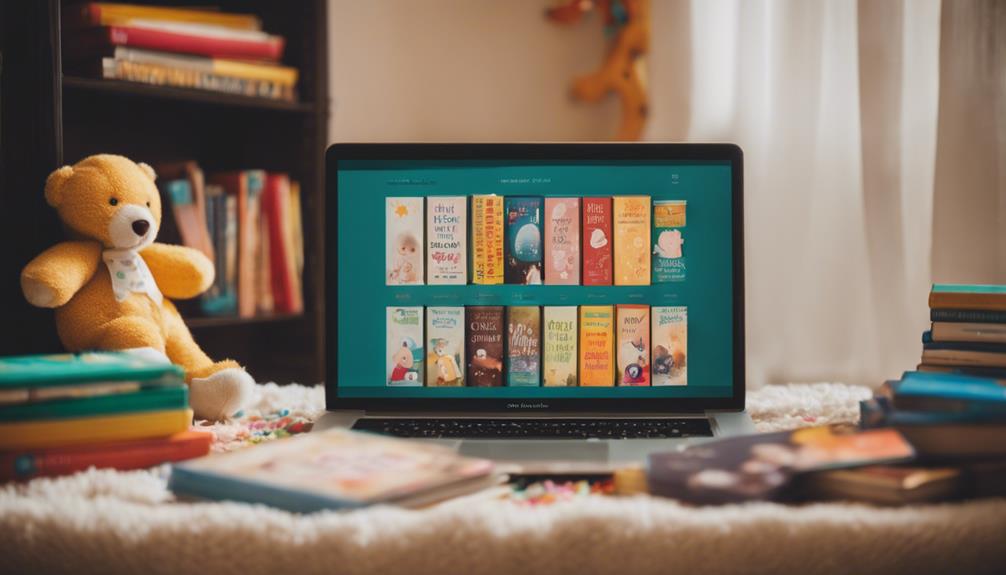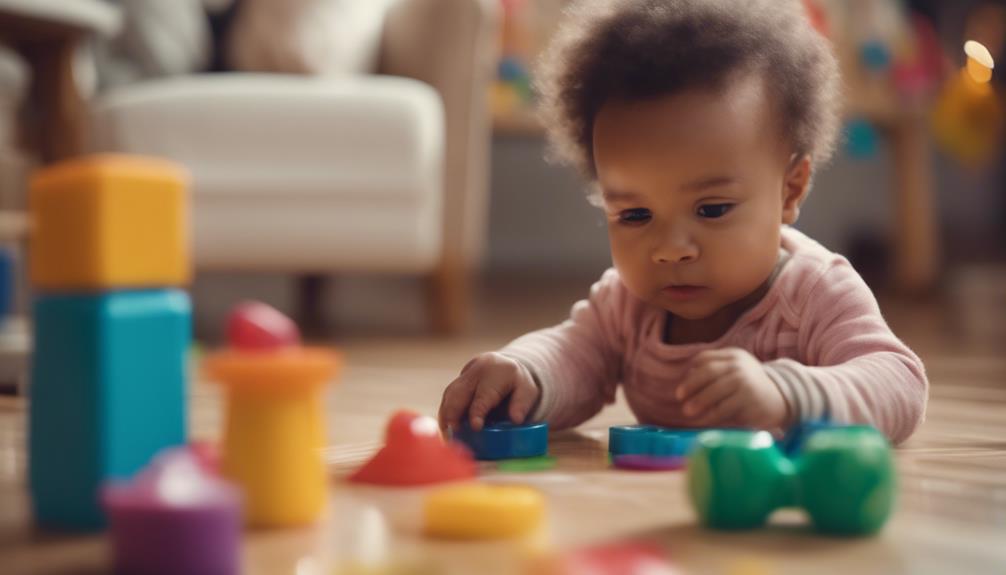Understanding your infant’s signals is essential for fostering a strong emotional connection. Recognizing hunger cues, such as sucking sounds or the rooting reflex, ensures timely feeding for comfort. Identifying sleep cues, like yawning or eye rubbing, helps establish healthy bedtime routines. Bright eyes, smiles, and reaching out indicate a desire to engage and play, which supports cognitive and social development. Watch for signs of overstimulation, such as increased fussiness, in order to create a soothing environment. By responding promptly to your baby’s cues, you build trust, security, and positive developmental outcomes. For more guidance on nurturing a positive parent-child relationship, click here.
Key Takeaways
- Respond promptly to hunger, tiredness, play, and break cues.
- Recognize hunger cues like sucking noises and rooting reflex.
- Identify sleep cues such as yawning and rubbing eyes.
- Understand play cues like bright eyes, smiles, and reaching hands.
- Watch for signs of overstimulation to ensure baby's comfort.
Importance of Baby Cues
Why are baby cues so essential in understanding your baby's feelings and needs?
Baby cues, communicated through body language like crying, facial expressions, body movements, and sounds, serve as crucial indicators of your baby's well-being. By paying attention to these cues, you can decipher what your baby is trying to communicate, whether they're hungry, tired, in pain, or seeking comfort. Responding promptly to these cues not only addresses your baby's immediate needs but also fosters a sense of security and trust in the parent-child relationship.
Understanding your baby's body language and cues enables you to respond appropriately, ensuring their needs are met effectively. This responsiveness not only promotes a harmonious parent-baby interaction but also aids in building a strong emotional bond.
Types of Baby Cues

Understanding the different types of baby cues is essential to effectively responding to your baby's needs and fostering a strong parent-child bond. Learning your baby's hunger cues, tiredness cues, play cues, and cues indicating a need for a break is vital in providing the right care at the right time.
When your baby is hungry, you may notice sucking noises, turning towards the breast, or rooting as signs of hunger. Signs of tiredness include staring, jerky movements, yawning, fussing, and sucking fingers.
Readiness to play cues involve bright eyes, smiles, smooth movements, and reaching hands, indicating your baby is ready for interaction and engagement. On the other hand, cues indicating a need for a break can include turning the head away, squirming, or kicking, suggesting that your baby may need some downtime.
Recognizing Hunger Cues
To understand hunger cues in babies, pay attention to signs like sucking noises, rooting reflex, and hand-to-mouth movements. Recognizing these cues early can help guarantee your baby from getting overly hungry and upset.
Signs of Hunger
Recognizing hunger cues in babies involves observing subtle signs like sucking noises, rooting, and hand-to-mouth movements. Your baby may also turn towards the breast or display mid-cues such as stretching, squirming, or increased physical activity when hungry.
Keep an eye out for crying and agitation, as these are feed-me cues indicating your baby is already quite hungry. It's vital to time your baby's feedings well by recognizing these cues early on to feed them before they become upset.
By understanding and responding promptly to your baby's hunger cues, you can guarantee their nutritional needs are met efficiently. Remember, each baby may have slightly different cues, so it's important to observe and learn your baby's unique signals to establish a smooth feeding routine.
Paying attention to these signs not only helps in meeting your baby's physical needs but also strengthens your bond through responsive care.
Timing of Feedings
Paying close attention to the early and mid-level hunger cues is vital for timing your baby's feedings effectively. By recognizing these cues promptly, you can help your baby feel satisfied and prevent them from reaching a state of extreme hunger. Early cues such as stirring, mouth opening, and head turning indicate that your baby wants to eat soon.
As hunger progresses, mid-level cues like stretching, physical movements, and hand-to-mouth gestures become more prominent, signaling a stronger desire for food. Missing these early signs is common, especially after sleep, so staying vigilant for subtle indicators is important.
Responding promptly to your baby's hunger cues can prevent them from becoming overly upset or agitated, which can lead to difficulty in feeding. If you observe feed-me cues like crying, agitation, or turning red, it's important to address your baby's needs promptly to safeguard their comfort and well-being.
Responsive Feeding Cues
By staying attentive to your baby's hunger cues, you can effectively respond to their feeding needs and guarantee their comfort and well-being.
Recognizing hunger cues is vital for responsive feeding. Your baby may show early cues like stirring, mouth opening, turning the head, or hand-to-mouth movements. As hunger increases, mid cues such as stretching and physical movements become more apparent.
When your baby is ready to feed, feed-me cues like crying, agitation, and turning red indicate urgent hunger. It's crucial to feed your baby before they reach this point to ensure successful feeding and prevent distress.
Missing early and mid cues, especially after sleep, can make it challenging to read your baby's cues accurately. By learning to interpret these hunger cues effectively, you can establish a harmonious feeding routine and promote your baby's overall well-being.
Stay mindful and responsive when it comes to recognizing when your baby is ready to eat.
Identifying Sleep Cues

To identify sleep cues in babies, watch out for signs such as yawning, rubbing eyes, and fussiness. These are indications that your baby is feeling tired and ready for sleep. Additionally, observe if your little one starts to slow down movements and decreases interaction, as these can also be cues that they're getting sleepy. Recognizing these sleep cues is essential for establishing a bedtime routine and promoting healthy sleep habits in infants.
Please be aware that babies may exhibit different cues when they're overtired, such as increased fussiness and difficulty settling down. By responding promptly to your baby's sleep cues, you can prevent them from becoming overly tired and help them ease into sleep more easily. Paying attention to these signals and acting accordingly can make a significant difference in your baby's sleep patterns and overall well-being.
Understanding Play Cues

When observing your baby, keep an eye out for cues such as bright eyes, smiles, smooth movements, and reaching hands, as these are indications that they're ready and enthusiastic to engage in playful interactions.
Responding to these play cues is vital for fostering a positive parent-child bond and supporting healthy development. Engaging in activities like talking, singing, and playing with toys can greatly benefit your baby's cognitive and social skills.
By recognizing and responding to these cues, you not only enhance your baby's overall well-being but also create moments of joy and learning. Playtime provides a wonderful opportunity for bonding and growth, so make sure to capitalize on these cues to create meaningful interactions with your baby.
Responding to Discomfort Cues
Promptly responding to your baby's discomfort cues is vital for providing comfort and support. When your baby displays discomfort cues such as crying, fussiness, arching their back, or pushing hands away, it's essential to address these signals promptly.
These cues indicate your baby's needs and the desire for attention and care from you. By recognizing and responding to these facial expressions and behaviors, you can help soothe your baby and prevent further distress.
Meeting your baby's needs promptly not only provides comfort but also fosters a sense of security and trust in your relationship. By being attentive and responsive to your baby's discomfort cues, you can create a supportive environment that promotes your baby's well-being and strengthens your bond.
Signs of Overstimulation
Recognizing signs of overstimulation in your baby is essential for maintaining their comfort and well-being. When your baby displays signs of overstimulation, such as furrowed brows, clenched fists, intense crying, arched back, and fussiness, it's important to respond promptly to help them feel better.
Here are some cues you can take to identify if your baby is overstimulated:
- Physical Discomfort: Watch out for signs of physical discomfort like increased agitation or restlessness.
- Difficulty Calming Down: If your baby is finding it hard to calm down despite your usual soothing techniques, they might be overstimulated.
- Low-Stimulation Environment: Creating a calming environment with minimal noise and visual distractions can help your baby regain their equilibrium.
- Prompt Response: Responding promptly to signs of overstimulation is vital to prevent further distress in your little one.
Understanding and addressing these cues can make a significant difference in your baby's well-being and comfort.
Building Bond Through Communication

To build a strong bond with your baby, it is essential to actively engage in communication by recognizing and responding to their cues. By understanding and meeting your baby's needs through effective communication, you can foster a deep and meaningful relationship. Communication with your baby goes beyond words – it involves observing their body language, facial expressions, and sounds to interpret what they are trying to convey. When you respond to your baby's cues with care and attentiveness, you are showing them that you are there to meet their needs, which promotes trust and security in the relationship.
| Benefits of Building Bond Through Communication | |||
|---|---|---|---|
| Strengthens parent-child bond | Fosters trust and security | Enhances developmental outcomes | Promotes emotional connection |
Recognizing and responding to your baby's cues is a powerful way to connect with them on a deeper level and build a strong foundation for your relationship.
Nurturing Positive Parent-Child Relationship

Nurturing a positive parent-child relationship involves actively engaging with your baby's cues to build trust and emotional connection. As a new parent, it can be overwhelming to decipher your baby's signals, but with time and practice, you'll begin to recognize their subtle hints.
Here are some key ways responding to your baby's cues can enhance your relationship:
- Strengthening Bonds: By responding promptly to your baby's cues, you show them they can rely on you, fostering a sense of security.
- Effective Needs Meeting: Understanding your baby's cues enables you to address their needs promptly, promoting trust and emotional well-being.
- Enhanced Communication: Positive interactions based on reading cues create a strong foundation for effective communication and emotional bonding.
- Crucial for Development: Recognizing and responding to your baby's cues plays an important role in laying the groundwork for their healthy development and overall well-being.
Embracing these practices won't only deepen your connection with your baby but also contribute to their long-term growth and happiness.
Frequently Asked Questions
Why Is It Important for Educators to Read an Infant's Cues Accordingly?
Understanding an infant's cues is essential for educators. It fosters trust, enhances care quality, and boosts emotional well-being. By reading cues accurately, you can tailor activities to meet needs, promoting social and emotional skills development in babies.
What Are the 4 Ways Infants Communicate?
Infants communicate through crying, body language, facial expressions, and vocalizations. Understanding these cues helps caregivers respond effectively to their needs. Pay attention to these signals to provide the best care and comfort for your baby.
What Are the 3 Ways That a Baby Communicates?
Babies communicate through crying, body language, and facial expressions. Crying expresses needs and emotions. Body language, like hand gestures, conveys feelings. Facial expressions, such as smiling or frowning, show comfort levels. Understanding these cues fosters strong parent-child bonds.
How Do You Know What Your Baby Is Saying?
You decode your baby's messages by tuning in. Observe their cues – body language, sounds, expressions. Listen closely, respond with care. Building this connection boosts trust, comfort, and deepens your bond with your little one.
Conclusion
Just like interpreting a complex puzzle, decoding your baby's cues is a skill that takes time and practice. By paying close attention and responding with care, you can strengthen the bond between you and your little one.
Remember, communication is a two-way street, and by understanding your baby's cues, you're laying the foundation for a strong and loving relationship. Keep observing, keep listening, and keep nurturing that special connection.









